#melanitta deglandi
Explore tagged Tumblr posts
Text
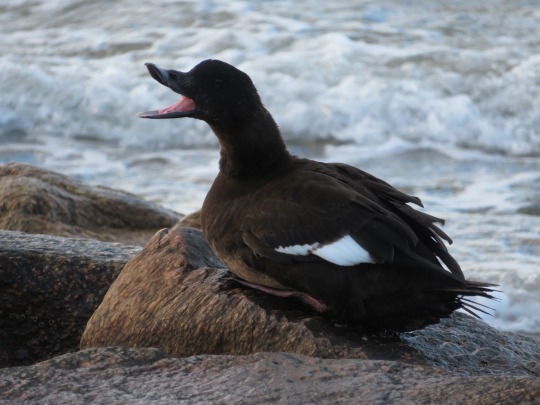


White-winged scoter | 12.03.24
22 notes
·
View notes
Text
Melanitta kirbori Zelenkov, 2024 (new species)

(Type coracoid [shoulder bone] of Melanitta kirbori, from Zelenkov, 2024)
Meaning of name: kirbori = for Kirill Borisovich Gerasimov [Russian zoologist who passed away in 2023]
Age: Pleistocene (Calabrian), about 1.8 million years ago
Where found: Taurida Cave, Crimea, Ukraine
How much is known: A nearly complete right coracoid (shoulder bone).
Notes: Melanitta is the genus of scoters, a group of stocky ducks in which the males are mostly colored black and have distinctive, "lumpy" bills. Although scoters tend to breed on freshwater ponds and lakes, they often spend the winter on coastal marine waters. They feed mainly by diving for clams and crustaceans.
M. kirbori is the oldest known scoter in the fossil record. It was similar in size and morphology to the extant surf scoter (M. perspicillata) of North America. It also resembles three larger extant species, the white-winged (M. deglandi), velvet (M. fusca), and Stejneger's (M. stejnegeri) scoters, which may suggest that these species evolved from smaller ancestors that were closer in size to M. kirbori.
Reference: Zelenkov, N.V. 2024. The oldest finds of the genera Melanitta, Marmaronetta, and other ducks (Aves: Anatidae) from the Lower Pleistocene of the Crimea. Paleontological Journal 58: 593–603. doi: 10.1134/S0031030124600653
47 notes
·
View notes
Text
White-winged Scoter
(Melanitta deglandi)
public domain photos from inaturalist (left and right by chrismcv, bottom by stevestevens)
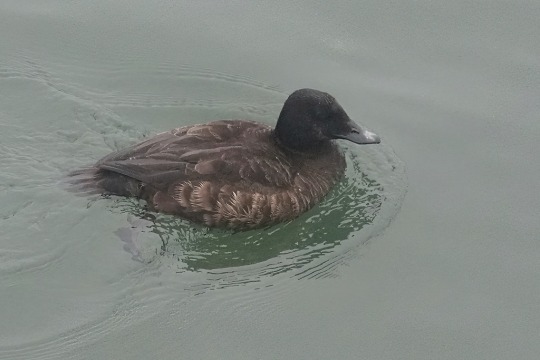


#other’s photos#white-winged scoter#white winged scoter#duck#bird#animal#bird life list#my life list
1 note
·
View note
Photo
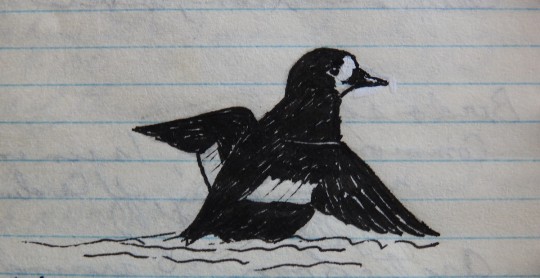
White-winged Scoter (Melanitta deglandi)
© Lee Jones
5 notes
·
View notes
Text
Melanitta
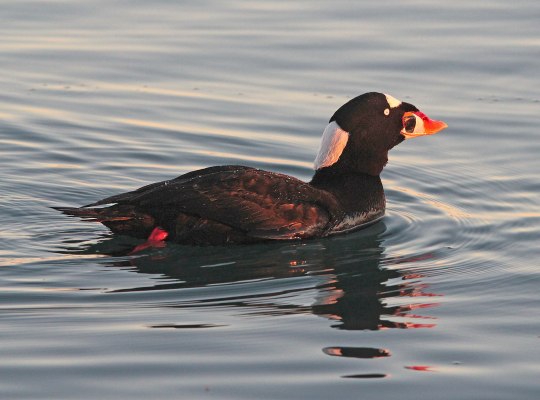
Surf Scoter by Alan Schmierer, in the Public Domain
PLEASE SUPPORT US ON PATREON. EACH and EVERY DONATION helps to keep this blog running! Any amount, even ONE DOLLAR is APPRECIATED! IF YOU ENJOY THIS CONTENT, please CONSIDER DONATING!
Name: Melanitta
Status: Extant
First Described: 1822
Described By: Boie
Classification: Dinosauria, Saurischia, Eusaurischia, Theropoda, Neotheropoda, Averostra, Tetanurae, Orionides, Avetheropoda, Coelurosauria, Tyrannoraptora, Maniraptoriformes, Maniraptora, Pennaraptora, Paraves, Eumaniraptora, Averaptora, Avialae, Euavialae, Avebrevicauda, Pygostylia, Ornithothoraces, Euornithes, Ornithuromorpha, Ornithurae, Neornithes, Neognathae, Galloanserae, Anseriformes, Anseres, Anatoidea, Anatidae, Merginae
Referred Species (all extant): M. americana (Black Scoter), M. nigra (Common Scoter), M. fusca (Velvet Scoter), M. deglandi (White-Winged Scoter), M. perspicillata (Surf Scoter)
Today’s dinosaurs are the Scoters, a group of fairly black seaducks with distinctive swollen bills (though all of the females are browner and more speckled in appearance). They form large flocks on the coasts, and actually take off together in these huge flocks. There are five living species, and for now, no extinct species are known.
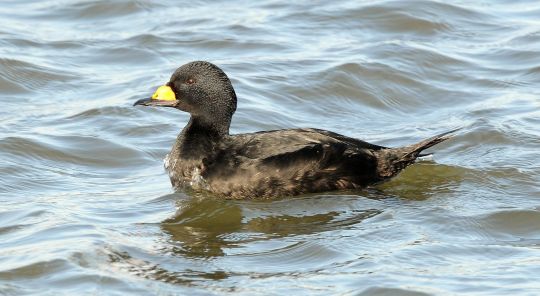
Black Scoter by Peter Massas, CC BY-SA 2.0
The Black Scoter, also known as the American Scoter, is a near-threatened large sea duck, weighing near 1 kilogram and found primarily in tundra of North America and easternmost Siberia. They not only have a bulky shape, but a very bulky bill with a yellow hump. They breed in the farthest north part of their range, and can be found further south in the winter, even spending the season as far south as the Great Lakes. They dive for crustaceans and molluscs on the sea coasts, though when they venture into freshwater they primarily feed on insects and larvae, as well as fish eggs and some plants. Their flocks are tightly packed on the coastal waters, though they are less social in the breeding season. They lay eggs close to the sea or in the tundra, with 5 to 7 eggs at a time, and only the females incubate the eggs. The young are flightless for about three weeks after hatching, during which time their mother protects them.

Common Scoter by Jason Thompson, CC BY 2.0
The Common Scoter is a non-threatened seaduck, bulky in shape with large lumpy bills. The bills are black with yellow patches. They live in Northern Europe and Asia, found in the tundra environment during the summer for the breeding season, and occasionally found as far south as Morocco during the winter. They form huge, tightly packed flocks on the coast that take off and dive together. The males have no white on their bodies, which makes them distinct from other Scoter species. They lay nests near the sea or in the tundra, and feed primarily on crustaceans and molluscs. Though not threatened with extinction, certain populations in the United Kingdom are on a sharp decline.

Velvet Scoter by Vince, CC BY 2.0
The Velvet Scoter is a threatened species, with smaller populations than the previous two species. They live during the winter in temperate Europe and Asia, and they nest in the far north, like other Scoters. They make nests on the ground close to the sea, where they dive for crustaceans and mollusks. They are bulky, with primarily yellow bills, and white patches on the wings, while the females are more brown. They are very rarely spotted in their range.

White-Winged Scoter by Lea Blumin, CC BY 2.0
The White-Winged Scoter is a non-threatened species, weighing nearly 2 kilograms in some cases, making them an extremely heavy species of Scoter - in fact, probably the heaviest of all. They breed in Western and Northern Canada and Alaska, and spend the winters along both the Atlantic and Pacific coasts, even sometimes far north along those coasts. To get to their winter range, they’ll even migrate and rest along the great lakes. They are very similar to the Velvet Scoter, but are currently considered to be a different species. They Are often found in Asia as well, even as far south as China. They form tightly packed flocks, which disband for the breeding season. They lay 5 to 11 eggs in a nest near the sea or lakes and rivers, and incubate them for a month. The females can be aggressive towards one another during the breeding season, and the young stay with the mother for about three weeks; and then together without the mom for another three weeks. Like other species in this genus, they feed on molluscs and crustaceans in the ocean, and insects and other crustaceans in freshwater.
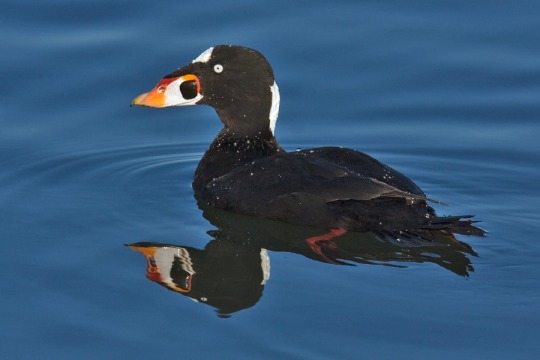
Surf Scoter by Alan D. Wilson, CC BY-SA 2.5
The Surf Scoter is the last species in the genus, and a rather large one, weighing up to 1 kilogram in the males. The males are a very velvety black except for its beak, which is distinctively patterned with red, orange, white, and black. Their white patches on their heads make them very visually distinct from other Scoters. The females, however, are mottled brown, and less visually distinctive. THey spend the breeding season in Northern Canada and Alaska, and winter along the coasts of both oceans, even as far south as Mexico and Texas. They breed in boreal forests near northern freshwater lacks, which is different than other species. They breed during the summer and females protect the nests on their own, and though the mothers take care of the young at first, they abandon the young before they are able to fly. The offspring congregate in small groups, before going to the wintering grounds on their own and joining up with the adults.
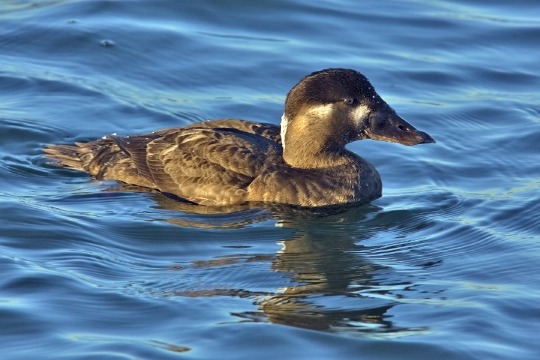
Surf Scoter by Alan D. Wilson, CC BY-SA 2.5
It feeds primarily on ocean invertebrates, and they’ll form small groups during the breeding season to eat a lot of different types of freshwater invertebrates, though their primary food is still ocean invertebrates, especially crustaceans and molluscs. They do shift their diet depending on food availability, indicating opportunism in the species - both in terms of what they eat and where they eat, often switching habitats to find more food. They will even capture food and eat it whole. They migrate over a variety of routes, usually with females and juveniles sticking together and the males in their own group. There are estimated to be up to a million of these birds throughout the world.
Buy the author a coffee: http://ko-fi.com/kulindadromeus
Sources:
https://en.wikipedia.org/wiki/Scoter
https://en.wikipedia.org/wiki/Black_scoter
https://en.wikipedia.org/wiki/Common_scoter
https://en.wikipedia.org/wiki/Velvet_scoter
https://en.wikipedia.org/wiki/White-winged_scoter
https://en.wikipedia.org/wiki/Surf_scoter
#melanitta#scoter#bird#dinosaur#duck#birblr#seaduck#black scoter#common scoter#velvet scoter#shite-winged scoter#surf scoter#melanitta americana#melanitta nigra#melanitta fusca#melanitta deglandi#melanitta perspicillata#dinosaurs#biology#a dinosaur a day#a-dinosaur-a-day#dinosaur of the day#dinosaur-of-the-day#science#nature#factfile#Dìneasar#דינוזאור#डायनासोर#ديناصور
40 notes
·
View notes
Photo
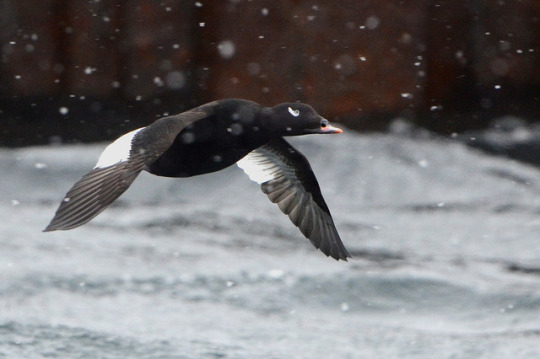
White-winged Scoter (Melanitta deglandi) - photo by Vince Filteau
36 notes
·
View notes
Photo
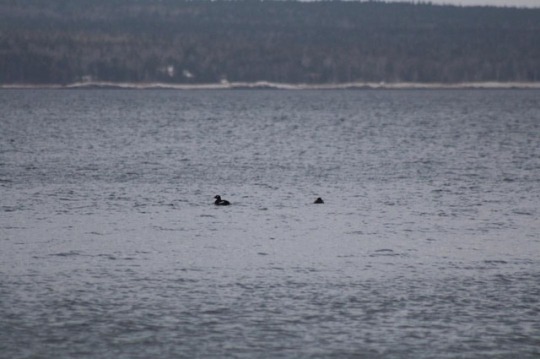
White-winged Scoters (Melanitta deglandi) ————————————————————— #halifax #novascotia #canada #explorenovascotia #explorecanada #birds #birding #ocean #maritimes #mammals #reptiles #insects #hiking #photography #animals #nature #wildlife #your_best_birds #nuts_about_birds #thebirdingsquad #becausecanada #animalfanatics #nature_sultans #bestnatureshots #eye_for_earth #addictedto_nature #spring #winter #summer #fall (at Port Mouton, Nova Scotia) https://www.instagram.com/p/BuwC5J5gpOl/?utm_source=ig_tumblr_share&igshid=jf4ru7cn6e1s
#halifax#novascotia#canada#explorenovascotia#explorecanada#birds#birding#ocean#maritimes#mammals#reptiles#insects#hiking#photography#animals#nature#wildlife#your_best_birds#nuts_about_birds#thebirdingsquad#becausecanada#animalfanatics#nature_sultans#bestnatureshots#eye_for_earth#addictedto_nature#spring#winter#summer#fall
0 notes